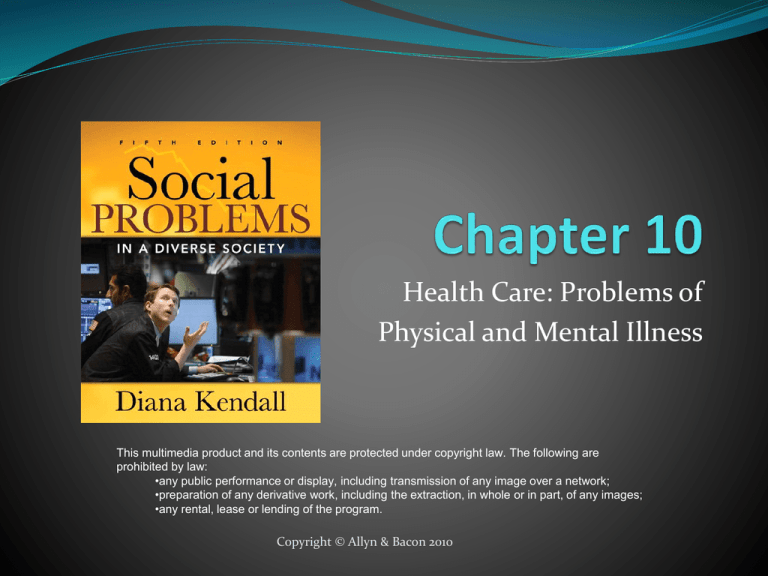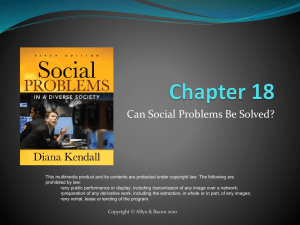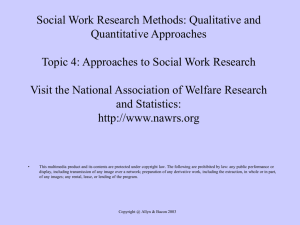Chapter 10
advertisement

Health Care: Problems of Physical and Mental Illness This multimedia product and its contents are protected under copyright law. The following are prohibited by law: •any public performance or display, including transmission of any image over a network; •preparation of any derivative work, including the extraction, in whole or in part, of any images; •any rental, lease or lending of the program. Copyright © Allyn & Bacon 2010 Chapter outline Health Mental Illness Health Care Sociological Explanations • Life expectancy and infant mortality • Diseases and Disability • AIDS • Defining • Treatment • Race, Class, Gender • • • • Private Health Insurance HMO/PPO Medicare and Medicaid Race, Class, Gender • Functionalist • Conflict • Interactionist Copyright © Allyn & Bacon 2010 Health and Life Expectancy Health: state of complete physical, mental, and social well-being. This is a social issue as well as a biological issue. Life expectancy is an estimate of the average lifetime of people born in a specific year 1900 – expected to live to 47.3 years of age 2005 – expected to live to 77.8 years of age Life expectancy varies by gender, race, social class and overall health Copyright © Allyn & Bacon 2010 Infant Mortality Number of deaths of infants under one year of age per 1,000 live births Good indication of societies preventive medical care IMR higher in US than other high-income nations Rates vary significantly by race In 2004, IMR for African American infants was 13.2 per 1,000 live births In 2001, IMR for white infants was 5.7 per 1,000 live births Indicates unequal access to health care in US Copyright © Allyn & Bacon 2010 Copyright © Allyn & Bacon 2010 Disease Acute diseases Illnesses that strike suddenly and cause incapacitation or death Chicken pox, influenza, Lyme disease, and HIV Chronic diseases Long-term, develop gradually, or are present from birth (e.g., arthritis, diabetes, heart disease) Caused by biological and environmental factors Some produce disabilities that increase health care costs Copyright © Allyn & Bacon 2010 Disability Disability: A restricted or total lack of ability to perform certain activities as a result of physical limitations or the interplay of these limitations, social responses, and the social environment. 54 million people in U.S. have 1 or more physical or mental disabilities. This number is increasing due to: Today people survive with disability that would have died before Longer life expectancy means more likely to have chronic disease Those born with serious disabilities more like to survive today due to medical advances Copyright © Allyn & Bacon 2010 AIDS Crisis Number of cases is rising annually Between 1,039,000 and 1,185,000 had AIDS/HIV in 2003 Up to 40,000 new cases each year Males account for nearly ¾ of all cases Half of those infected are African American Higher rates for those between age 25 and 44 Treatment is complex and costly, currently no cure Copyright © Allyn & Bacon 2010 Mental Health Considered a social problem because it affects a large number of people 1 in 4 adults suffer from a diagnosable mental disorder Difficult to define and identify mental disorders American Psychiatric Association’s (1994) Diagnostic and Statistical Manual of Mental Disorders IV (DSM-IV) Lists of disorders changes and grows with each revision Severe mental illness (schizophrenia, bipolar disorder, major depression) affect 1 out of 17 US adults some time in their lives Many direct and indirect costs of mental illness to our society. Copyright © Allyn & Bacon 2010 Copyright © Allyn & Bacon 2010 Race, class, gender and mental illness No significant differences in diagnosable mental illness between African Americans and whites Racism does however impact the psychological well-being of both African Americans and whites Social class is related to mental illness As SES increases for African Americans and whites, mental disorders decrease Gender differences in Mental Illness: Women are diagnosed with depression more than men Men have higher rates of personality disorders (gambling, drinking, etc.) Copyright © Allyn & Bacon 2010 Health Care Crisis Currently medical care is offered on fee for service basis Patients pay directly for treatment Expensive way of delivering health care because there are few restrictions on how much providers can charge Private Health Insurance Pay the insurance company a premium and they pay the provider directly Health care costs started spiraling with increase in medical insurance programs in the 1960’s Copyright © Allyn & Bacon 2010 Today’s options In order to reduce medical costs and demand many insurance companies are offering options: Preferred Provider Organizations (PPOs) Doctors contract to treat insured patients for set fees Health Maintenance Organizations (HMOs) For a set monthly fee, an HMO provides total care Emphasis is on prevention Patients must use doctors and hospitals affiliated with HMO Managed Care Any system of cost containment that controls tests, procedures, and services Copyright © Allyn & Bacon 2010 Medicaid and Medicare Medicare Public health insurance for people aged 65 and over Funded by social security payments Medicaid Public health insurance for people who are poor and either aged, blind, disabled, or pregnant Funded by federal and state governments Uninsured and underinsured: 47 million Americans had no health insurance in 2006 Some companies are cutting medical benefits Copyright © Allyn & Bacon 2010 Copyright © Allyn & Bacon 2010 Race, class, gender and health care Less preventive care and less optimal management of chronic diseases are received by: People of color across class lines Low-income whites Much Gender inequality in health care: Women have been underrepresented in the medical profession Medical training, practice, and research are male-centered 80% of doctors in U.S. are men today Women receive differential treatment for certain kinds of medical problems Copyright © Allyn & Bacon 2010 Explanations of health care problems Functionalist: Illness is dysfunctional for society, keeps people from fulfilling their roles. Problems in U.S. health care are due to macro-level changes (e.g., high-tech medicine, over-specialization of doctors) Solutions Reorganize the whole healthcare system Cost containment needs to happen Managed care is the best answer Copyright © Allyn & Bacon 2010 Explanations of health care problems (cont.) Conflict: Health problems are rooted in capitalism and in the medical-industrial complex Race-, class-, and gender-based inequities cause health problems Inequality in U.S. health care will be perpetuated by 3 things: High health care costs due to advanced services and expensive medicine and technology Abuse of existing systems by health care professionals who overcharge, provide unnecessary services, or charge for services never received Aging population will put a strain on Medicare and Medicaid. Copyright © Allyn & Bacon 2010 Explanations of health care problems, cont. Symbolic Interactionist Communication problems between doctors and patients create problems Can help this by increasing the number of family practice Drs. Increase communication between dr. and patient People need to become more involved in health care issues and reform People who have information and resources could work on preventative care at home reducing need for some high cost care. Copyright © Allyn & Bacon 2010









